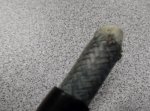You have several issues to deal with to achieve maximum performance. If properly designed, the receiver multicoupler should help you a lot. However, you will need a pre-selector filter ahead of the preamp and a small attenautor between the preamp and your 4 way splitter. Since you have only told us your 3 repeaters are spread over 8 MHz, then for discussion I will assume the Tx frequencies are maybe 462.2, 463.5 and 464.9, with the receive frequencies at 467.2, 468.5 and 469.9, which places the outside frequencies about 8 MHz apart. With this in mind, your pre-selector needs to be aligned for 467.2 to 469.9 and any excess bandwidth needs to be above 469.9 to maximize the attenuation on the transmit frequencies. The preselector can be a simple & compact 4 to 6 resonator filter like the old Celwave HFE8459A usually found on Ebay for around $130, and the bandwidth is typically 3 MHz with 2 dB loss. Attenuation on the nearest Tx frequency is about 25 dB and greater on the others. Many older two-way shops have these in-stock.
The output attenuator is required to reduce the excess gain of the preamp. If you were to buy the Mini-Circuits ZX60-P103LN+ for $65, the gain is about 18 dB. The 4-way splitter like the Mini-Circuits ZB4PD-462W-N+ for $110 with N connectors has 7 dB loss. Cables add maybe another 3 dB loss, so the preamp will be running 8 dB hot, which will reduce the dynamic range of the repeater receivers and raise the potential of interference by at least 8 dB. Therefore you need to install an 8 db attenuator BETWEEN the preamp and splitter. Terminate the spare splitter port with a small 50 ohm load and wait to install your 4th repeater. That should make all the receivers great.
The proper way to combine the transmitters is to use a dual-junction Isolator on each transmitter and combine with two 3 dB Hybrid couplers. These will allow you to operate the repeaters on any frequencies, including adjacent channels without interference. You will lose about 7 dB per channel if you had 4 repeaters, but with three channels, one channel would be 3.5 dB down. Your repeaters are likely running far more power out than is necessary so the loss of power is of no consequence. Each hybrid will require a load adequate to handle 50% of the power out from the two repeaters to each. If the repeaters are set to 50 watts each, the you will need [25+25] a 50 watt load that will get really warm.
The hybrids are listed on Ebay as “hybrid couplers” and the perfect model is the Sage 751, Microlabs CA-25N or several Narda models. Some 3 dB hybrids like the Microlabs CA-15N designed for 200-400 MHz can work out of range with a small power imbalance between ports. Watch Ebay as these do come available in the $25 to $100 range.
The dual-junction isolators can be hard to find, but you can use two singles in series. I will be listing on Ebay about 80 used single junction MA-COM circulators for 430-470 MHz soon, so I know these are available. Typically on Ebay, singles go for $75 -$125 and dual-junction go for $125-$175.
You will require a low pass filter between the Hybrids and your SINGLE TRANSMIT ANTENNA. I hope this helps. If you need more info or diagrams, just ask.



